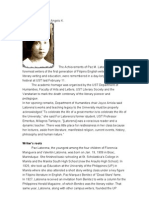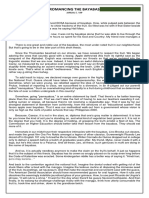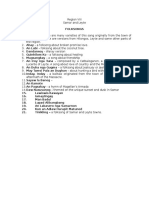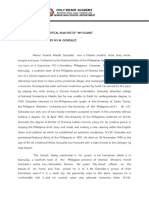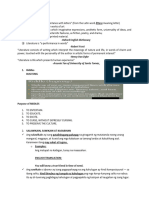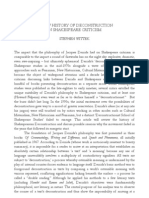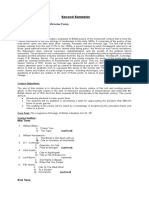AMBAHAN
AMBAHAN
Uploaded by
Caranay BillyCopyright:
Available Formats
AMBAHAN
AMBAHAN
Uploaded by
Caranay BillyCopyright
Available Formats
Share this document
Did you find this document useful?
Is this content inappropriate?
Copyright:
Available Formats
AMBAHAN
AMBAHAN
Uploaded by
Caranay BillyCopyright:
Available Formats
Asbury College Inc.
Poblacion Anda Pangasinan 2405
A. Y. 2023 - 2024
Group 1
BSed III Major in English
EL 113 SURVEY OF PHILIPPINE LITERATURE IN ENGLISH
BILLY CARANAY - INSTRUCTOR
TITTLE : AMBAHAN
INTRODUCTION
The Ambahan poem is a form of traditional Filipino poetry that originates from the
Mangyan people in the Philippines. Region 4-B, also known as MIMAROPA
(Mindoro, Marinduque, Romblon, and Palawan), is home to various indigenous
groups, including the Mangyan. This report delves into the Ambahan poem within the
context of Philippine literature in English, focusing on its characteristics, cultural
significance, and representation in Region 4-B.
DISCUSSION
Ambahan is a traditional poetic form of the Mangyan people, an indigenous group
from the Philippines. It's primarily used by the Hanunuo Mangyan community and is
considered a significant cultural and literary expression. Ambahan typically consists
of seven-syllable lines, with rhythmic patterns and metaphors that convey deeper
meanings and insights about life, nature, and the Mangyan way of life. These poems
are often carved onto bamboo using a special script and are chanted or sung during
various occasions. Ambahan serves as a way to pass down cultural values, wisdom,
and stories from one generation to the next
Characteristics of Ambahan Poem:
1. Syllable Count
: Ambahan poems consist of seven syllables per line, with each stanza typically
containing six to eight lines.
2. Rhyme and Rhythm
: While Ambahan poems do not adhere strictly to rhyme and meter, they have a
melodic rhythm that stems from their traditional oral recitation.
3. Nature and Human Themes
: These poems often revolve around themes of nature, human experiences, and
emotions, capturing the connection between humans and their environment.
4. Concealed Messages :
Ambahan poems may carry hidden messages, serving as a way for the Mangyan
people to express their thoughts, feelings, and wisdom.
Cultural Significance:
1. Oral Tradition: The Ambahan poem is deeply embedded in the oral tradition of the
Mangyan people. It has been passed down through generations as a means of
preserving their cultural heritage.
2. Communication: Ambahan poems were historically used as a form of
communication, allowing Mangyan individuals to share insights, stories, and values
with each other.
3. Cultural Identity: These poems play a crucial role in defining the cultural identity
of the Mangyan people, highlighting their unique perspective on life and nature.
4. Expression of Emotions: Ambahan poems provide an outlet for emotional
expression, enabling individuals to convey their innermost feelings through artful
language.
Representation in Region 4-B:
1. Mangyan Communities: The Mangyan people of Mindoro, particularly the
Hanunuo and Buhid groups, are the primary bearers of the Ambahan tradition in
Region 4-B.
2. Cultural Preservation: Despite modern influences, some Mangyan communities still
engage in composing and reciting Ambahan poems, contributing to the preservation
of their cultural heritage.
3. Literary Revival: Efforts have been made to promote and revive the appreciation of
Ambahan poetry, both within indigenous communities and among a wider Filipino
audience.
4. Educational Initiatives: Ambahan poems are now sometimes incorporated into
educational programs and initiatives, helping to raise awareness about indigenous
literature and culture.
Certainly, here are a couple of examples of Ambahan poems:
Example 1:
Sa búhay ng tao
Sá halagang kayamanan
Dahil sa kasaysayan,
Wala nang tadhana.
(Translation:
In the life of a person,
As precious as wealth,
Because of history,
Destiny is no more.)
Example 2:
Ang ánghel na waláng katawán
Ang búhay ay paglaláwan;
Ang kalangitang hindi náráratnan,
Di mo makáyaring makuha kailan.
(Translation:
The angel without a body,
Life is a journey;
The unattainable heavens,
You cannot possess forever.)
Example 3:
Kagubatan sa bukirin,
Yaring bundok ay dakila't mataás;
Sa bundok na ito,
Pitóng pook ang napuntahan.
(Translation:
A forest in the field,
This mountain is great and high;
On this mountain,
Seven places were visited.)
These examples showcase the concise and evocative nature of Ambahan poems. They
touch upon themes such as life, destiny, nature, and the human experience, often
delivering profound insights within their limited syllabic structure. Keep in mind that
Ambahan poems may have different interpretations and layers of meaning, reflecting
the poetic and cultural richness of the Mangyan tradition.
Conclusion:
The Ambahan poem stands as a testament to the rich cultural diversity of the
Philippines, particularly within the indigenous communities of Region 4-B. As a
unique form of traditional poetry, Ambahan serves as a vehicle for expressing
emotions, preserving cultural identity, and communicating wisdom. Its revival and
integration into modern educational efforts highlight the importance of recognizing
and celebrating the indigenous literary heritage of the Philippines.
You might also like
- Coach RecordDocument1 pageCoach RecordCaranay Billy100% (4)
- Legend of The FireflyDocument5 pagesLegend of The FireflyLucita Salva0% (1)
- Ibalon (Three Heroes of The Bicol Epic)Document1 pageIbalon (Three Heroes of The Bicol Epic)graxia04100% (1)
- Hinilawod EpicDocument35 pagesHinilawod Epicangel guzi0% (1)
- The Concise Oxford History of Indian BusinessDocument19 pagesThe Concise Oxford History of Indian Businessankursonicivil0% (1)
- The Life and Times of Angela Manalang GloriaDocument14 pagesThe Life and Times of Angela Manalang Gloriaaintenough100% (1)
- You Lovely People: Beinvenido SantosDocument8 pagesYou Lovely People: Beinvenido SantosFranzelle Yvone AbdonNo ratings yet
- Dance As Enacted Mimetic PerformanceDocument17 pagesDance As Enacted Mimetic PerformanceTrisha Yvonne FabularNo ratings yet
- Alamat Ni Maria MakilingDocument6 pagesAlamat Ni Maria MakilingTim Erasmus100% (1)
- MidsummerDocument15 pagesMidsummerBrixylle Anne100% (1)
- Paz M. LatorenaDocument4 pagesPaz M. LatorenaAngeloMuñozNo ratings yet
- Notable Filipino Authors and Their WorksDocument33 pagesNotable Filipino Authors and Their WorksIcy PallananNo ratings yet
- Moonlight On Manila BayDocument13 pagesMoonlight On Manila BayJunsan, Mark James A.50% (2)
- Historical Background: Chapter 10: The Period of The Third Republic (1981-1985)Document5 pagesHistorical Background: Chapter 10: The Period of The Third Republic (1981-1985)Raquel LimboNo ratings yet
- When I See A Barong-BarongDocument7 pagesWhen I See A Barong-BarongRhona Zein NiezNo ratings yet
- Frustrated WishDocument2 pagesFrustrated WishMa. Georgette Tapic50% (2)
- Timeline of Philippine LiteratureDocument6 pagesTimeline of Philippine LiteratureJay Mark Cada ArreNo ratings yet
- Jose Garcia VillaDocument5 pagesJose Garcia Villamaricon elleNo ratings yet
- A Stylistic Analysis of The Poem - To A Lost OneDocument10 pagesA Stylistic Analysis of The Poem - To A Lost OneDragneel MeridaNo ratings yet
- Tuwaang Attends A Wedding and Tungkung Langit & Alunsina (PDF - Io)Document7 pagesTuwaang Attends A Wedding and Tungkung Langit & Alunsina (PDF - Io)Anna Liza Lope - MotolNo ratings yet
- Philippine Literature During The American Period: English German Anthology of Poetsedited byDocument6 pagesPhilippine Literature During The American Period: English German Anthology of Poetsedited byAramis FreyaNo ratings yet
- L8 Eastern Visayas LiteratureDocument25 pagesL8 Eastern Visayas LiteraturePSHNo ratings yet
- Through Ages and Ages Eternal by Conrado VDocument3 pagesThrough Ages and Ages Eternal by Conrado VPearl AlanoNo ratings yet
- AmbahanDocument15 pagesAmbahankarl facturanNo ratings yet
- Summary of Biag Ni LamDocument1 pageSummary of Biag Ni LamReonel Ferreria100% (1)
- Tales of ManuvuDocument3 pagesTales of ManuvuFranchezca EnriquezNo ratings yet
- Why The Dead Come Back No MoreDocument3 pagesWhy The Dead Come Back No MorecharlesNo ratings yet
- BalagtasDocument1 pageBalagtasDesiree CalpitoNo ratings yet
- Biag Ni LamDocument3 pagesBiag Ni LamVivien Indira Pascua60% (5)
- Severino MontanoDocument1 pageSeverino MontanoShanina Mae FlorendoNo ratings yet
- Sonnet 1 PoetryDocument6 pagesSonnet 1 PoetryWenslette Imee C. BalauroNo ratings yet
- Romancing The Bayabas by Januar E. YapDocument2 pagesRomancing The Bayabas by Januar E. YapderlshepsieNo ratings yet
- Fashion of The IgorotsDocument22 pagesFashion of The IgorotswendybalaodNo ratings yet
- Chapter Ix - Literature in SoccsksargenDocument7 pagesChapter Ix - Literature in SoccsksargenFruit Cakes100% (1)
- Four Sonnets: Toribia ManoDocument4 pagesFour Sonnets: Toribia ManoQueenie Carale100% (1)
- Middle East - Literary BackgroundDocument5 pagesMiddle East - Literary BackgroundSampaga, Lovely Grace FerraroNo ratings yet
- Poem AnalysisDocument6 pagesPoem AnalysisNesvelle Mae Pascua100% (6)
- The Tale of KamanduanDocument7 pagesThe Tale of Kamanduananon_81894548No ratings yet
- 21st Century Literature FINALSDocument8 pages21st Century Literature FINALStinNo ratings yet
- Lesson 2 - Music of Mindoro & PalawanDocument23 pagesLesson 2 - Music of Mindoro & PalawanAbegail Hernandez100% (1)
- 21st Century Rethinking The Tower of BabelDocument2 pages21st Century Rethinking The Tower of Babelbea locsin100% (2)
- Region VIIIDocument1 pageRegion VIIIManuelito UyNo ratings yet
- Do You Believed in Love at First Sight?: Unknown StoryDocument13 pagesDo You Believed in Love at First Sight?: Unknown StoryFrancis Bryan Hantal PatinoNo ratings yet
- Tungkung Langit and AlunsinaDocument3 pagesTungkung Langit and AlunsinaBruz SundayNo ratings yet
- When I See A Barong BarongDocument11 pagesWhen I See A Barong BarongRanie Monteclaro100% (1)
- LiteratureDocument9 pagesLiteratureAlexandra NalapoNo ratings yet
- Walking HomeDocument2 pagesWalking HomeJeremy DupaganNo ratings yet
- Peta in 21stDocument2 pagesPeta in 21stAira Agbuya100% (2)
- Interpretation of Be Beautiful, Noble, Like The Antique AntDocument1 pageInterpretation of Be Beautiful, Noble, Like The Antique AntFaye AribuaboNo ratings yet
- Indarapatra at SulaymanDocument4 pagesIndarapatra at SulaymanMark Agabus Apanti0% (1)
- Carlos A. AngelesDocument1 pageCarlos A. AngelesKaly RieNo ratings yet
- Canonical Authors: That Exposed The Ills of The Society.)Document3 pagesCanonical Authors: That Exposed The Ills of The Society.)Kimberley Sicat BautistaNo ratings yet
- MontageDocument2 pagesMontageKeiKoNo ratings yet
- Paz M. Latorena: Background Information and AchievementsDocument8 pagesPaz M. Latorena: Background Information and AchievementsChrisbert ImperialNo ratings yet
- Biag Ni Lam-AngDocument10 pagesBiag Ni Lam-AngRonald Arlan Peramo Grajo100% (4)
- Bicolano WritersDocument40 pagesBicolano Writerskristel.erpeNo ratings yet
- 21 ST Century Lit Module 3Document6 pages21 ST Century Lit Module 3aljohncarl qui�onesNo ratings yet
- Handout Q3 Lesson1 21STDocument18 pagesHandout Q3 Lesson1 21STstella argonilloNo ratings yet
- Overview of Unit 1Document14 pagesOverview of Unit 1SAMNo ratings yet
- Survey of The Philippine Literature in EnglishDocument4 pagesSurvey of The Philippine Literature in EnglishHannah LagnasonNo ratings yet
- LITERATURE MidtermreviewerDocument8 pagesLITERATURE MidtermreviewerFiery RoseyNo ratings yet
- Super FINAL ORGANIZATION AND MANAGEMENT Q2 Week13Document22 pagesSuper FINAL ORGANIZATION AND MANAGEMENT Q2 Week13Caranay BillyNo ratings yet
- Super FINAL ORGANIZATION AND MANAGEMENT Q2 Week16Document24 pagesSuper FINAL ORGANIZATION AND MANAGEMENT Q2 Week16Caranay BillyNo ratings yet
- Super FINAL ORGANIZATION AND MANAGEMENT Q2 Week14Document19 pagesSuper FINAL ORGANIZATION AND MANAGEMENT Q2 Week14Caranay BillyNo ratings yet
- Letter of RequestDocument1 pageLetter of RequestCaranay BillyNo ratings yet
- Practical Research 2 Quarter 2 Week 9Document4 pagesPractical Research 2 Quarter 2 Week 9Caranay Billy100% (2)
- Lesson 1 DiassDocument9 pagesLesson 1 DiassCaranay BillyNo ratings yet
- Quarter 4 - Module 4: Power, Impact, and Implications of Media and InformationDocument40 pagesQuarter 4 - Module 4: Power, Impact, and Implications of Media and InformationCaranay Billy33% (3)
- Edited Questionnaire 1Document6 pagesEdited Questionnaire 1Caranay BillyNo ratings yet
- Tournament Format and Needed TOsDocument1 pageTournament Format and Needed TOsCaranay BillyNo ratings yet
- Detailed Lesson Plan in Arts - SMTCDocument13 pagesDetailed Lesson Plan in Arts - SMTCCaranay BillyNo ratings yet
- Practical Research 2 Quarter 1 Week 1Document4 pagesPractical Research 2 Quarter 1 Week 1Caranay Billy100% (1)
- Reading in Philippine HistoryDocument5 pagesReading in Philippine HistoryCaranay BillyNo ratings yet
- Practical Research 1 - Quarter 1 - Module 1 - Nature and Inquiry of Research - Version 3Document53 pagesPractical Research 1 - Quarter 1 - Module 1 - Nature and Inquiry of Research - Version 3Caranay Billy100% (1)
- Scores Dalumat Unit4Document2 pagesScores Dalumat Unit4Caranay BillyNo ratings yet
- Quarter 3 - Module 3: Languages and Policies in Media and InformationDocument44 pagesQuarter 3 - Module 3: Languages and Policies in Media and InformationCaranay Billy90% (10)
- Media Information LiteracyDocument32 pagesMedia Information LiteracyCaranay BillyNo ratings yet
- New TKD Rules For Palaro - Div - Pang.iDocument8 pagesNew TKD Rules For Palaro - Div - Pang.iCaranay BillyNo ratings yet
- Music8 Quarter 2 Module 2Document23 pagesMusic8 Quarter 2 Module 2Caranay Billy90% (10)
- MIL11 Q4 Mod5 Version 3 Ampong RonaldDocument69 pagesMIL11 Q4 Mod5 Version 3 Ampong RonaldCaranay Billy75% (12)
- Sample Task Sheet - MAPEH FTL 7 - PEDocument5 pagesSample Task Sheet - MAPEH FTL 7 - PECaranay BillyNo ratings yet
- Hope - 1 Grade 11: Exercise For FitnessDocument17 pagesHope - 1 Grade 11: Exercise For FitnessCaranay Billy0% (1)
- Dramatizing Time in Twentieth Century Fiction 1st Edition William Vesterman All Chapter Instant DownloadDocument84 pagesDramatizing Time in Twentieth Century Fiction 1st Edition William Vesterman All Chapter Instant Downloaditawilishya100% (15)
- A Brief History of Deconstruction in Shakespeare CriticismDocument10 pagesA Brief History of Deconstruction in Shakespeare Criticismchaucer13501523No ratings yet
- Robert FrostDocument1 pageRobert FrostAmbreen MahmoodNo ratings yet
- Kerala Public Service CommissionDocument76 pagesKerala Public Service CommissionVijisha KNo ratings yet
- Skylark Summary AnalysisDocument33 pagesSkylark Summary AnalysisSmriti Thakur100% (3)
- Megara SteleDocument4 pagesMegara SteleVoislavNo ratings yet
- Introduction To Prose (Fiction)Document11 pagesIntroduction To Prose (Fiction)Parlindungan PardedeNo ratings yet
- Cavalier Poet - WikipediaDocument4 pagesCavalier Poet - Wikipediasa46851No ratings yet
- International Journal of Applied Linguistics & English LiteratureDocument278 pagesInternational Journal of Applied Linguistics & English LiteraturechioNo ratings yet
- HIST3 Prelim Materials (5 Lessons) - 16-20 PDFDocument5 pagesHIST3 Prelim Materials (5 Lessons) - 16-20 PDFIsabel Jost SouribioNo ratings yet
- James, Elaine T - Landscapes of The Song of Songs - Poetry and Place-Oxford University Press (2017)Document249 pagesJames, Elaine T - Landscapes of The Song of Songs - Poetry and Place-Oxford University Press (2017)Leonardo CruzNo ratings yet
- Keeping Quiet Poem, Class 12Document4 pagesKeeping Quiet Poem, Class 12Tushar GuptaNo ratings yet
- EDSC 304 Poetry Lecture Guided NotesDocument6 pagesEDSC 304 Poetry Lecture Guided NotesJeff DiazNo ratings yet
- 01 Clase 11 de Junio de 2011 LullabyDocument12 pages01 Clase 11 de Junio de 2011 LullabyCecilia Mercedes MendozaNo ratings yet
- Ballad of The Mothers HeartDocument3 pagesBallad of The Mothers HeartJirah Capitulo100% (1)
- UNIT 3 Work On The TextDocument16 pagesUNIT 3 Work On The TextAna Bella FranciscoNo ratings yet
- SummaryDocument5 pagesSummarymisobod8No ratings yet
- After The VictoriansDocument7 pagesAfter The VictoriansSix minutesNo ratings yet
- Feasibility of Using Colonial Undertones in Nonsense Poetry: A Study of Sukumar Ray's Abol TabolDocument6 pagesFeasibility of Using Colonial Undertones in Nonsense Poetry: A Study of Sukumar Ray's Abol TabolDR. Shemim BegumNo ratings yet
- CSEC English SBA HandoutDocument13 pagesCSEC English SBA Handoutafsanaally95No ratings yet
- English Project On Poets and PancakesDocument8 pagesEnglish Project On Poets and PancakesVETRIZONE SRIVETRINo ratings yet
- Creative Writing: A Short Guide To Teaching Imaginative ThinkingDocument4 pagesCreative Writing: A Short Guide To Teaching Imaginative ThinkingMarcoNo ratings yet
- MA Eng 2nd SemDocument13 pagesMA Eng 2nd SemWAQAS MURTAZANo ratings yet
- The Poetical Works of Thomas HoodDocument810 pagesThe Poetical Works of Thomas HoodGuillermo Romero von ZeschauNo ratings yet
- To The Man I Married ReportDocument4 pagesTo The Man I Married ReportRobispiere Renielle Francisco100% (2)
- Dadaism: Art Movement: OriginDocument6 pagesDadaism: Art Movement: Originsunq hccnNo ratings yet
- 1 Year English Guess Paper: Book-IDocument3 pages1 Year English Guess Paper: Book-IDr. Hina HinaNo ratings yet
- Various Themes and Their Treatment in W.B. Yeats's PoetryDocument3 pagesVarious Themes and Their Treatment in W.B. Yeats's PoetryMuhammad Hasnain100% (1)
- Antolog Palat Patonvol 1Document528 pagesAntolog Palat Patonvol 1Javier Hernández GarcíaNo ratings yet










